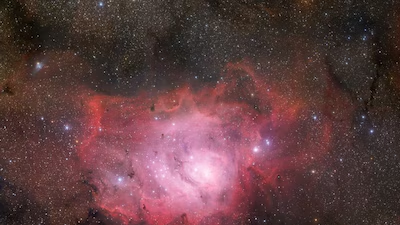Introduction
Astrophotography continues to deliver jaw-dropping glimpses into the vast cosmos. In a recent capture, astrophotographer Greg Meyer unveiled a breathtaking portrait of the Lagoon Nebula (Messier 8) and the Trifid Nebula (Messier 20), two of the Milky Way’s most famous stellar nurseries. This deep-sky image, collected over 34 hours from Arizona’s pristine dark sky sites, offers stunning detail of regions where stars are being born, located roughly 4,000 light-years away in the Sagittarius constellation.
Astrophotographer Captures Vivid Portrait
According to Space.com, Meyer used a Sky-Watcher Esprit 80 mm telescope and a Player One Poseidon M Pro camera to capture this image north of Ash Fork, Arizona. Employing narrowband filters allowed him to highlight distinct emission lines from interstellar gas, rendering sharp contrasts between glowing ionized clouds and dark dust filaments that weave through the frame.
Using tracking peripherals, PixInsight, and Adobe tools for post-processing, Meyer transformed raw data into a luminous tapestry showcasing active star formation zones in our galactic neighborhood.
The Lagoon Nebula: A Furious Star Factory
The Lagoon Nebula, dominating the left of the image, spans about 100 light-years. It’s a seething region filled with hot gas where stars are forming at an astonishing rate. Its swirling knots of glowing gas and dark tendrils of dust highlight the turbulence of ongoing stellar creation. Deep within, bright stellar clumps illuminate the surrounding gas, forming radiant cavities within the nebula’s structure. A Hubble Space Telescope image from 2004 first showcased these bright clumps, but Meyer’s wide-field image offers a sweeping cosmic landscape.
The Trifid Nebula: Beauty in Contrast
Just above and to the right sits the Trifid Nebula. Unlike the Lagoon, Trifid is smaller but no less dramatic. It displays vivid color contrasts between red hydrogen emissions, blue reflection nebulosity, and dark dust lanes slicing through the glowing clouds. The intricate interaction of young massive stars and molecular clouds makes the Trifid a favorite target for astronomers studying star formation dynamics.
These nebulae are part of the Sagittarius Star Cloud, one of the densest regions of stars visible in the Milky Way, making it a treasure trove for astrophotographers and astronomers alike.
The Science Behind Stellar Nurseries
Such stunning images are more than just visual wonders—they offer valuable insights into how stars are born. Stellar nurseries like the Lagoon and Trifid form inside giant molecular clouds, where gravity triggers the collapse of gas and dust into protostars. Over millions of years, these young stars sculpt their surroundings, shaping knots of gas, carving dark lanes, and illuminating their cosmic cradles with intense radiation.
While powerful telescopes like the James Webb and Hubble provide detailed close-ups of such regions, wide-field astrophotography like Meyer’s reveals their larger context within the galaxy, offering a panoramic view of our dynamic universe.
Conclusion
Greg Meyer’s 34-hour deep-sky composition of the Lagoon and Trifid Nebulas beautifully captures both the artistic and scientific marvels of our galaxy. These vibrant clouds of gas and dust remind us that even in the cold vacuum of space, the process of star birth continues in brilliant fashion. For more stunning space discoveries and updates, visit The Morning News Informer.


